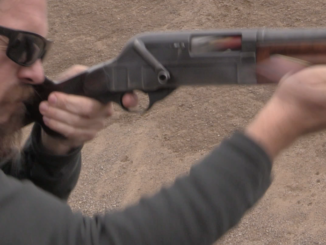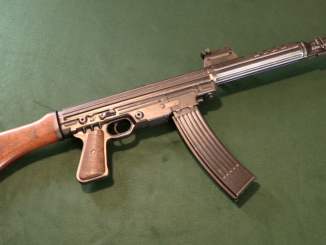The 1880s saw a brief explosion of experimental manually-operated repeating handguns, mostly throughout Europe. The most common weapon of this type known in the US is the Volcanic pistol, forerunner to the Winchester lever-action rifles. In Germany and Austria, however, a bunch of different guns of this type were developed.
The one we are looking at today is a Berger, dating from 1880/1881. Unlike most of these guns, it could be described as a double action mechanism – a single rearward trigger pull runs the complete loading/firing/ejecting cycle. In most manually operated handguns, the rearward pull loads and fires, while a forward push of the trigger extracts and ejects the fired case (much like a lever-action rifle).




Ian:
My understanding is that the pistol carries five rounds in the tube magazine with an empty (or empty casing) chamber so it would negate the proclivity of the other revolvers to have the hammer resting on an empty chamber or in a dangerous condition. So the five-round capacity would not be anything new to a user. It should not be any more troublesome to load than say a Colt and the complete action would not be as prone to collect dirt/mud/etc as the revolvers. It also has a much narrower cross sectional profile so would be more concealable than a revolver of that time. If it had been made in a more powerful round I can see very little wrong with the design eventhough I am certain that it had at least a few “birthing defects’ as do most new designs. Overall, it is intriguing.
The breech action seems like a cross between the Spencer (rotating rearward-“falling” breechblock)and the Remington-Rider (with the hammer breast backing up the breechblock at the instant of firing).
The magazine feed is more-or-less straight Winchester. Although the magazine loading system is closer to Marlin’s.
As for the caliber, I strongly suspect it was the British 0.320in revolver, aka .32 Short Colt. Introduced around 1870, it was quite common on the Continent, mostly in Belgian-made knockoffs of the Webley Bull Dog and RIC type pocket revolvers, as well as Adams “clones”. Its very short OAL would just about match the space available here.
While the manual repeaters were flatter overall than a similar caliber revolver, they tended to be longer front-to-back due to the necessary length of the magazine tube. As such, they made more sense as holster weapons than concealed-carry arms. Or would have, if they had been made in full-bore service calibers, which they weren’t.
The manual repeaters’ main claim to fame is showing designers how not to build a true self-loading pistol.
cheers
eon
“in full-bore service calibers”
Does longer cartridge mean bigger force needed to repeat? If so how big force can be accepted (or how longest cartridge can be used)?
In the blackpowder era, the major factor was that for higher velocities, more powder was required, because even with different grain sizes (Fg down to FFFg) you can’t really tailor burning rates as much as you can with smokeless powder.
As such, for more power, you needed a longer cartridge case to stuff powder into, irrespective of bore diameter.
There’s a limit to how long a cartridge you can reasonably handle in an action like this. Remember, unlike a lever-action rifle (or shotgun), you will be operating the lever (“racking the action”) with at most two fingers. Or in this case, the trigger finger alone. That limits the amount of force you can exert, even allowing for mechanical advantage. Keep in mind, most lever actions do not rotate the bolt on unlocking, thus there is no primary extraction.
The 1950s vintage Winchester Model 88 lever-action rifle is a conspicuous exception to this rule, as its rotating bolt action was designed along the lines of that of the model 100 self-loading rifle, and both were based on the M1 Carbine bolt design. IIRC, the Sako Finnwolf lever-action rifle has a similar setup.(?)
There’s also a limit to lever throw in a weapon like the Berger, in terms of how far you can move the lever, and thus the breechblock. This too tends to impose a limit on cartridge OAL.
Also, even in rifles, rotating-block repeating actions had a problem handling overly long cartridges due to their geometry. The Spencer being a good example.
In short, high-powered short cartridges needed smokeless powder. Combining their higher pressure with the poor primary extraction of a Spencer-type breech and the lower force available with a short lever and only half the hand powering it pretty much ruled out high-powered lever-action “repeating handguns”.
Even if smokeless powder had been widely available at the time- which it wasn’t, and wouldn’t be for another decade.
cheers
eon
Alas, the manual repeater pistol was a dead end in everything except target shooting. And this pistol isn’t good for target shooting because of that trigger pull. I suppose gun makers went round in circles about manual repeaters being failures until somebody thought of Isaac Newton’s third law of motion… Or am I wrong?
Anyways, here’s a Weapon-of-choice scenario:
The wild, wild, wilderness… Nobody around except you, your friends, and a freight train along with the train’s crew. The cargo is mostly furniture, but there is an unusually heavy cabinet on this train. It was ordered by a particularly wealthy client for reasons not disclosed to the shipping firm (this may be why the boss put you on the train). In the event the locomotive suffers a breakdown far from the next rail yard, what will you have on hand to prevent any ugly situations with wildlife or bandits from happening?
1. Colt Single-Action Army or Remington Model 1875
2. Howdah Pistol
3. LeMat revolver
4. Side-by-side double barrel shotgun
5. Sharps Model 1863 or Snider-Enfield
6. Winchester Model 1886
7. Steyr-Mannlicher 1888 or a member of the earlier Steyr-Kropatschek family
8. 1891 Argentine Mauser
9. Mauser C96 or Nagant M1895 with suppressor (boy am I evil)
10. Get to the Hotchkiss 1898’s on the roof of the train!
11. Or per the usual, screw the budget and add your favorite toys to this list.
This activity is voluntary. You are not required to participate if you do not wish to do so. Please keep any and all criticism of this post humane and free of foul language.
Thank you,
Cherndog
“wild, wild, wilderness”
Assuming dense forest full-power cartridge seems to be unnecessary – with limited range of view ability to hit target far away can’t be utilized. So for me lever-action fire-arm for revolver-sized cartridge seems to be enough – to stay inside 19th century get Marlin Model 1894 or its predecessor – Marlin Model 1889.
Wilderness does not necessarily equal “forest”, aka “heavy cover” in tactical terms. So you should have a rifle (at least) capable of engaging targets within visual range, which I generally define as 300 meters.
The Winchester 1886 would be a good choice, as it was available for a variety of cartridges suitable for long range shooting, many of them actually designed for single-shot rifles. The .40-82 Winchester would probably be the best choice, since it was designed for long-range shooting and bringing down heavy game like elk.
A 260-grain bullet @ 1490 for 1285 FPE is an “intermediate” round by today’s standards, but in that era it was one of the most powerful rounds available, and having about a 200 F/S MV advantage over the .45-70 was a bit more accurate at range.
Not that the .45-70 would be a bad choice. In fact, a .45-70 “camel Gatling” would be a nasty surprise for any would-be “antiquers”. I would expect such a concealed shipment to include something along these lines unless the shipper and/or consignee were cockeyed optimists.
cheers
eon
Sticks of dynamite.
Don’t damage the goods you’re supposed to protect unless you like pay cuts… Hope you don’t dynamite bears.
Very cool pistol. Is the breechblock locked in place by the hammer, as is the case in a rolling block rifle?
Moving arc of breechbolt is in an upright contact with hammer radius. Recoil force through the breechbolt immobilize the hammer.
For more information: Please check US Patent;233 466.
“how not to build a true self-loading pistol.”
When FRANCOTTE REPEATING PISTOL was manufactured, photos can be seen here:
http://www.manebooks.com/firearms/francotte.htm
but I can’t find when it was manufactured. I’m wondering: was it developed independently from automatic pistol or designed to mimic automatic pistol aesthetic or ergonomics?